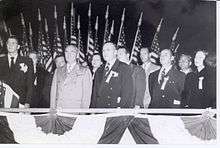Gilmore Stadium
Gilmore Stadium was a multi-purpose stadium in Los Angeles, California. It was opened in May 1934 and demolished in 1952, when the land was used to build CBS Television City. The stadium held 18,000. It was located next to Gilmore Field. The stadium was located west of Curson Avenue, surrounded by Beverly Boulevard, Fairfax Avenue and Third Street.
The stadium was built by Earl Gilmore, son of Arthur F. Gilmore and president of A. F. Gilmore Oil, a California-based petroleum company which was developed after Arthur struck oil on the family property.[1] The area was rich in petroleum, which was the source of the "tar" in the nearby La Brea Tar Pits.
Uses
Football venue
It was used for American football games at both the professional and collegiate level. The stadium was the home of the Los Angeles Bulldogs, the first professional football team in Los Angeles.[2] The Bulldogs competed as an independent team before joining the second American Football League in 1937 and winning its championship with a perfect 8-0-0 record, the first professional football team to win its championship with an unblemished record.[3] After the collapse of the league, the Bulldogs returned to being an independent team before joining the American Professional Football Association in 1939.[3] The Bulldogs then became charter members of the Pacific Coast Professional Football League in 1940[4] and played in Gilmore Stadium until 1948, when the team moved to Long Beach, California, for its (and the league's) final season.
Gilmore Stadium was also the site of two 1940 National Football League (NFL) Pro Bowls.
1940 NFL All-Star Game (1939 season)
On January 14, 1940, the 1939 NFL champion Green Bay Packers met an All-Star team consisting of players from the nine other NFL clubs in the second NFL All-Star game in history. The Packers won 16-7.[5]
1940 NFL All-Star Game (1940 season)
Extra seating was added to accommodate 21,000 fans for the Pro Bowl for the 1940 NFL season. The crowd set a record as the largest to view a Los Angeles pro game.[6] The event was held on December 29, 1940. The game pitted the 1940 NFL Champion Chicago Bears against an All-Star team from the other NFL clubs in the third NFL All-Star game. The Bears won 28-14.[6]
Baseball venue
The Hollywood Stars of the Pacific Coast League played here in 1939, while awaiting completion of Gilmore Field's construction.
Midget car venue
Midget car racing was invented at the track.[2] The track hosted midget car racing from the track's debut in May 1934 to 1950.[2][7] The 1939 Turkey Night Grand Prix was held at the track.[8]
Rodger Ward drove Vic Edelbrock's midget car in a famous August 10, 1950 event at Gilmore Stadium. Ward shocked the racing world by breaking Offenhauser engine's winning streak by sweeping the events at Gilmore Stadium that night.[9]
Notable drivers that raced at the track include Danny Bakes, Bill Betteridge, Fred Friday, Walt Faulkner, Perry Grimm, Sam Hanks, Curly Mills, Danny Oakes, Roy Russing, Bob Swanson, Bill Vukovich, Rodger Ward, and Karl Young.[7] Drivers that were killed at the track include Ed Haddad, Swede Lindskog, Speedy Lockwood, Frankie Lyons, and Chet Mortemore.[7]
In the sixteen years of the stadium's existence, over 5 million fans attended races at the track.[7] The stadium drew crowds over 18,000 people each race.[7] Attendance dropped to below 9,000 at normal weekly races by the late 1940s. The attendance drop and increased demand for property in West Hollywood led to the track's sale in 1950.[7] It was torn down in 1951. Some of its grandstand was installed at Saugus Speedway.[10]
Other uses
It also hosted donkey baseball, dog shows, rodeos, and at least one cricket match.[2] Esther Williams performed in a diving and water ballet performance. A temporary above ground pool was constructed for the event.[2] Several professional boxing title matches where held in the stadium.[11] U.S. President Harry S. Truman delivered his "stiff upper lip" speech in the stadium.
Gilmore Stadium was featured in a 1934 Three Stooges short featuring a football game, and fittingly titled Three Little Pigskins. The scoreboard, with the name of the stadium, appears prominently in several shots, as does a billboard advertising Gilmore products. A sign for the nearby Fairfax Theater, across Beverly Boulevard at the north (open) end of the stadium, is also visible in the background a couple of times.
On May 19, 1947, Gilmore Stadium was packed with people waiting to hear a speech by Progressive Party candidate for President Henry A. Wallace. Wallace served as vice president under FDR and was also the Secretary of Agriculture (his specialty) and Secretary of Commerce. Also speaking at the event was actress Katharine Hepburn, whose speech stole the show.

References
- ↑ "Gilmore Field". Project Ballpark. Retrieved January 11, 2014.
- 1 2 3 4 5 The history of Farmer's Market, Retrieved June 22, 2007
- 1 2 Bob Carroll, Michael Gershman, David Neft, and John Thorn, Total Football II: The Official Encyclopedia of the National Football League (HarperCollins 1999) ISBN 0-06-039232-0
- ↑ Kenosha Cardinals: Life on the Fringe (1983)
- ↑ January 1940 NFL Pro Bowl game
- 1 2 December 1940 NFL Pro Bowl game
- 1 2 3 4 5 6 THE GILMORE OIL COMPANY, Reprinted from Old Car Illustrated, Retrieved June 22, 2007
- ↑ Mel Hansen Biography at the National Midget Auto Racing Hall of Fame
- ↑ Biography for Vic Edelbrock at the National Midget Auto Racing Hall of Fame
- ↑ Wilkings, Marshall; Lyn Pherigo (1982). A Tip of the Hat to Saugus Speedway Champions. Santa Clarita Valley Historical Society. Retrieved 2007-12-10.
- ↑ Farmer's Market (part 2), Retrieved June 22, 2007
Coordinates: 34°04′28″N 118°21′36″W / 34.07444°N 118.36000°W
External links
| Preceded by Wrigley Field |
Home of the NFL All-Star Game 1939 and 1940 |
Succeeded by Polo Grounds |